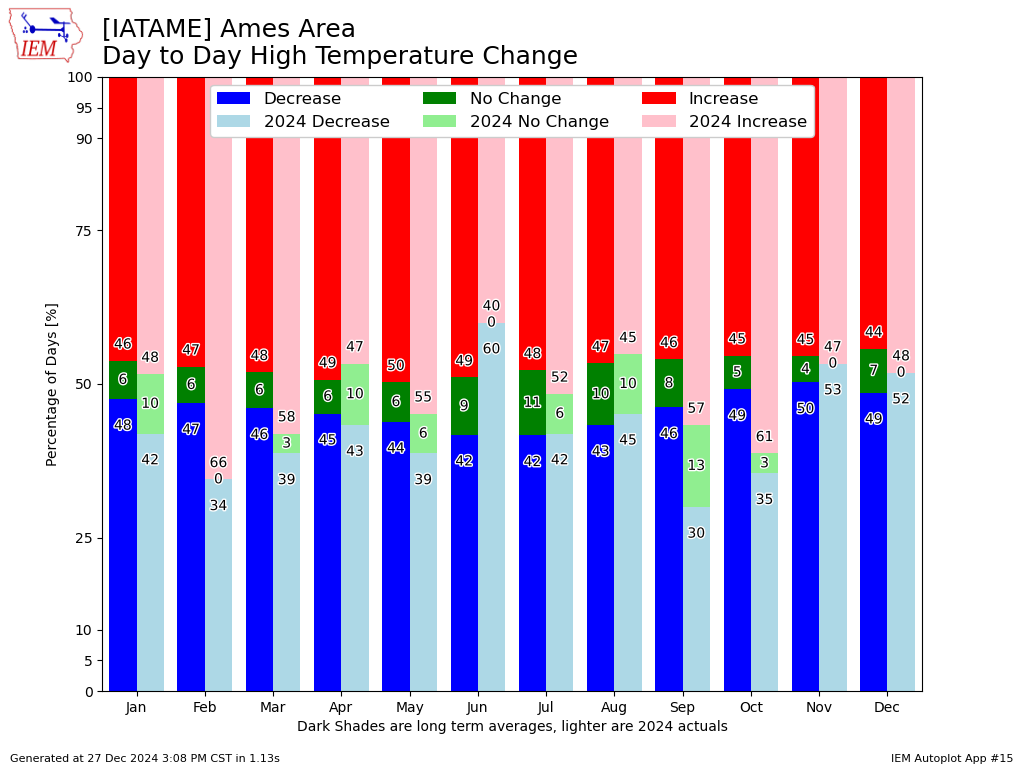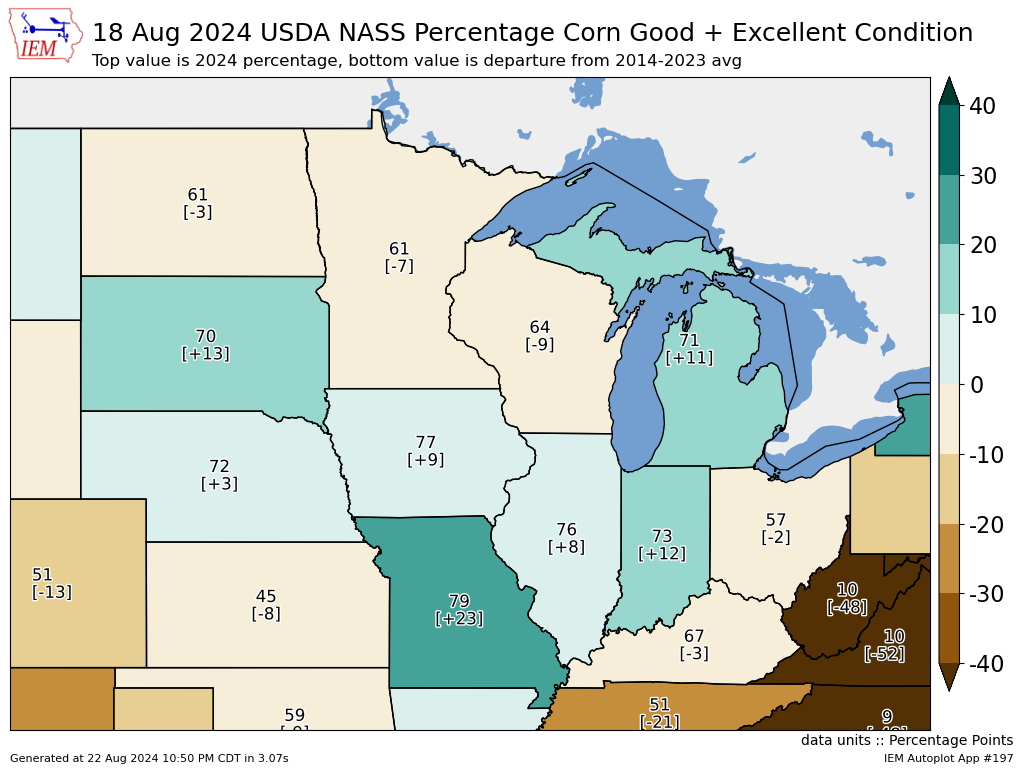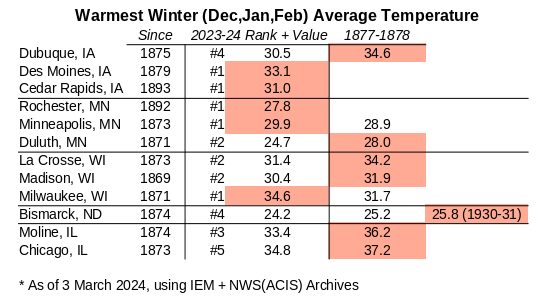Past IEM Features tagged: 2024
2024: Billions of Observations
31 Dec 2024 05:30 AMTo close out 2024, today's featured chart presents an estimate of the amount of new data added during 2024 and stored within the IEM PostgreSQL databases. Note that the numbers presented are not exactly point in time observations, but a measure of the number of database rows within various tables/relations. Please also note that the plot uses a logarithmic axis for readability. A small army of computer servers attempt to process numerous data streams into forms to be stored within a database. The featured chart totals an estimate of just under five billion rows of data added for the year! Most all of this data is made immediately available for download via numerous APIs and services. It is a considerable challenge to keep all of these data flows going, but the community feedback remains very positive with many usage cases at Iowa State University and beyond supported by this effort. Here's to another year of keeping the IEM chunking along!
Voting:
Good: 16
Bad: 0
Tags: 2024 iem archive
2024: Precipitation Departures
30 Dec 2024 09:30 AMGoing into 2024, the drought from 2023 was of great concern as significant precipitation departures had accumulated going into the spring of this year. A wet spring made up much of the deficits with the entire state being drought free by July. A very dry fall season followed, with drought concerns returning once again. Heavy rainfall events returned going into November and the result of all this "whip-lash" is the subject of today's featured map. It presents a crude analysis of station precipitation departures for the year to date period. A few portions of the state are shown a few inches below average with the most wide-spread dryness found over southwestern Iowa. We'll have another rain and snowfall event to end 2024 with some modest improvements perhaps to these deficits as the heaviest totals are expected over southern Iowa.
Voting:
Good: 4
Bad: 2
Tags: 2024
2024 Day to Day Changes
27 Dec 2024 03:14 PMWith just a few days of 2024 left, it is a good time to start reviewing the year that was. The featured chart presents the monthly frequency in day to day change of high temperature for Ames. The darker set of three colors represent the climatology and the lighter represent what happened so far during 2024. Of interest, is June. Climatology says it should have the fewest percentage of days with a high temperature cooler than the previous day. For 2024, the opposite was true with the highest percentage for the year with days cooler than the previous! The dry months of September and October nicely appear in this chart with larger than average frequencies of having a warmer than previous day. Will generate some more features like these to close out the year and welcome in 2025.
Voting:
Good: 8
Bad: 0
Tags: 2024
Good + Excellent Corn
23 Aug 2024 05:30 AMThe corn and soybean crops this year continue to look in great shape thanks to sufficient rain and limited hot weather. The featured map presents recent USDA NASS estimated percentage of corn crop acres currently in good or excellent condition. The values are color coded by departure from a recent ten year average approximately valid for this day of the year. Much of the corn belt is shown in great shape and much of the potential yield is already on board as corn reaches maturity. Soybeans could certainly still use more rain to support yields and even corn to help improve grain quality. August does look to end on a hot note, so more rain would certainly help reduce late season water stress.
Voting:
Good: 12
Bad: 0
Tags: nass corn 2024
Warmest Winter *
04 Mar 2024 05:30 AMFor the winter season comprising the months of December thru February and considering an average daily temperature, many sites in the upper Midwestern US had their warmest winter on record. As the feature title denotes, there is a bit of an asterisk to this statement. The asterisk is the consideration of the winter of 1877-1878, which is before the period of record starts for the vast majority of long term climate data for the region. The featured table presents some IEM computed winter season average temperature records for selected sites over the region. The warmest value is highlighted. For a number of sites with data for 1877-1878, that winter was much warmer than our most recently finished one. Minneapolis and Milwaukee are exceptions with this winter warmer than the 1877-1878 one. The official NCEI statewide data starts in 1895, so it may end up showing this winter as the warmest on record for a number of states (including Iowa), but that statistic would not include 1877-1878. Another interesting data point is Bismarck, ND, whose warmest winter was 1930-1931 and that even includes the 1877-1878 one.
Voting:
Good: 17
Bad: 1
Tags: winter 2024
February Record Highs
27 Feb 2024 05:30 AMIt was a record setting day in Iowa on Monday with the following first-order NWS climate sites either tying or setting new February high temperature records.
- Cedar Rapids 76 (ties 2017)
- Des Moines 78 (ties 1930)
- Dubuque 72 (beats 71 in 2017)
- Mason City 73 (beats 66 in 1981)
- Sioux City 77 (beats 75 in 1896)
- Waterloo 78 (beats 71 in 1921)
Having Waterloo and Mason City best their previous February records by seven degrees each is very remarkable! The featured chart presents the current monthly high temperature records for Dubuque. Temperatures will again be quite warm on Tuesday, but take a very abrupt downturn in the afternoon.
Voting:
Good: 17
Bad: 0
Tags: 2024 feb






